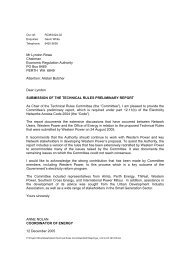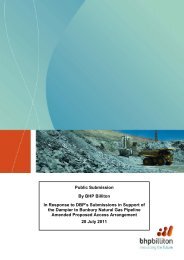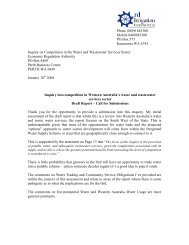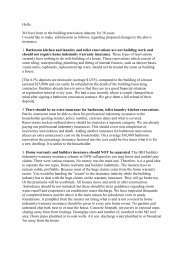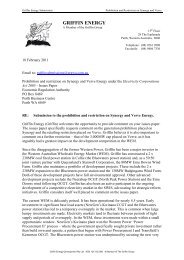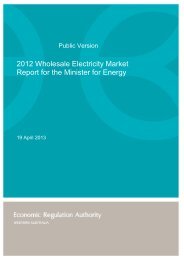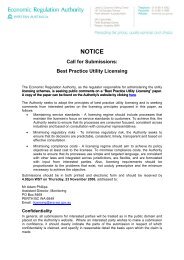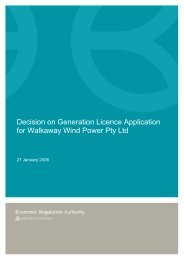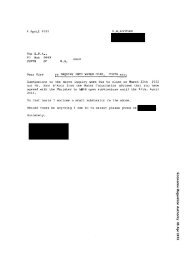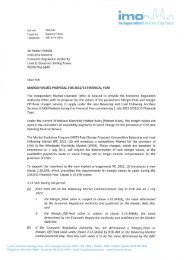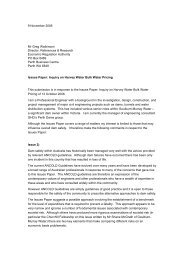Western Power Network Pricing - ERA Economic Regulation ...
Western Power Network Pricing - ERA Economic Regulation ...
Western Power Network Pricing - ERA Economic Regulation ...
You also want an ePaper? Increase the reach of your titles
YUMPU automatically turns print PDFs into web optimized ePapers that Google loves.
Tariff design<br />
The Draft Decision provides for tariffs for particular customer classes to be adjusted by 2 per cent in<br />
real terms per year beyond any changes in average tariffs. 29 Constraints on rebalancing different<br />
tariff classes within the same revenue cap are known as side-constraints. Rebalancing is considered<br />
to promote more efficient outcomes where it enables tariffs to remove internal cross-subsidies and<br />
move towards more cost-reflective levels<br />
The Council considers that as a general point, there needs to be close scrutiny by the Authority of<br />
movements in tariffs within tariff classes. This is consistent with the requirement in the ENAC for<br />
the Authority to consider and seek to avoid price shocks.<br />
The Council considers that the proposed real annual 2 per cent side-constraint adjustment is too<br />
large. A two per cent annual real adjustment could increase tariffs within a customer class by 10.4<br />
per cent in real terms over the five years of AA3 (independent of any other changes arise from the<br />
general direction of tariffs). This is a substantial rise in real terms and could be considered to impose<br />
a price shock.<br />
The Council disagrees with the argument that side-constraints of 2 per cent are necessary to provide<br />
<strong>Western</strong> <strong>Power</strong> with the opportunity to develop efficient price levels and structures. 30 <strong>Western</strong><br />
<strong>Power</strong> has not presented any specific evidence to support a significant reweighting of different tariff<br />
classes to more cost-reflective prices. The fact that costs are relatively stable across customer<br />
classes suggests it is not necessary to provide scope for a cumulative internal reweighting of tariffs in<br />
real terms of up to 10.4 per cent. Moreover, <strong>Western</strong> <strong>Power</strong> might use a side-constraint of 2 per<br />
cent to reweight tariffs not towards more cost-reflective tariff structures, but to shift costs to those<br />
customer classes where users are less able to avoid tariff increases in the short term. This would<br />
result in a less efficient tariff structure.<br />
The Council considers a 1 per cent side-constraint is more appropriate. Alternatively, the Authority<br />
may wish to provide <strong>Western</strong> <strong>Power</strong> with the ability to seek a side constraint change greater than<br />
1 per cent in a given year subject to close scrutiny by the Authority.<br />
In the absence of consumer ability to participate more fully in the wholesale market (see above), the<br />
Council encourages the Authority to require <strong>Western</strong> <strong>Power</strong> to develop off-peak tariff arrangements.<br />
At present, such tariffs are not available to residential customers, unlike most other jurisdictions<br />
within Australia. The Council considers that off-peak tariffs could and should be introduced within<br />
the AA3 period to encourage demand to shift from peak to off-peak times, enabling significant<br />
savings in capex. The Council notes that <strong>Western</strong> <strong>Power</strong>’s load duration curve shows that the use of<br />
the network is quite peaky. 31<br />
The Council does not support the compulsory imposition of time-of-use metering on consumers.<br />
29 <strong>ERA</strong> Draft Decision, p. 289, paragraph 1204.<br />
30 <strong>ERA</strong> Draft Decision, p. 290, paragraph 1210.<br />
31 GBA, p. 83, figure 7.3.<br />
23




